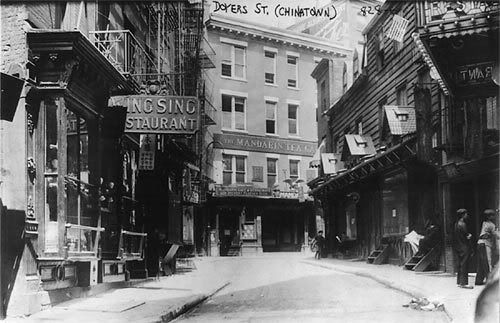
Taken about 1920, the opera house is on the left past the Wing Sing Restaurant
From the Vanishing New York blog
The street was named for Hendrick Doyer, a Dutchman who ran a distillery in the early 1800s where the post office is today. Doyer's became Doyers, thanks to "a careless painter of street signs" who "omitted the apostrophe," according to Herbert Asbury in an excellent 1926 essay about Doyers' distant history.
Known as the Bloody Angle, Doyers was the site of many battles between the Chinese tong gangs in the late 1800s and early 20th century. They killed each other with hatchets while "Disciples of the Pear Garden" sang onstage at the Chinese opera house. Doyers was also a good place to be shanghaied by a crimp or kidnapped into sexual slavery. There were opium dens and fan tan parlors. There were trapdoors, secrets openings, underground tunnels, and the infamous Arcade, a passageway that ran in an L-shape from Doyers to Mott.
Today Doyers is peaceful, but it's no empty alley like Freeman's was. A steady flow of Chinese pedestrians move through it, going to the barber shop, the post office, or just taking a shortcut. There's a sense of comfort and familiarity here. It is a vibrant community. In another great essay worth reading, Bruce Edward Hall calls Doyers "the nerve center through which throbs all the essential life of New York City’s Chinatown."


























No comments:
Post a Comment